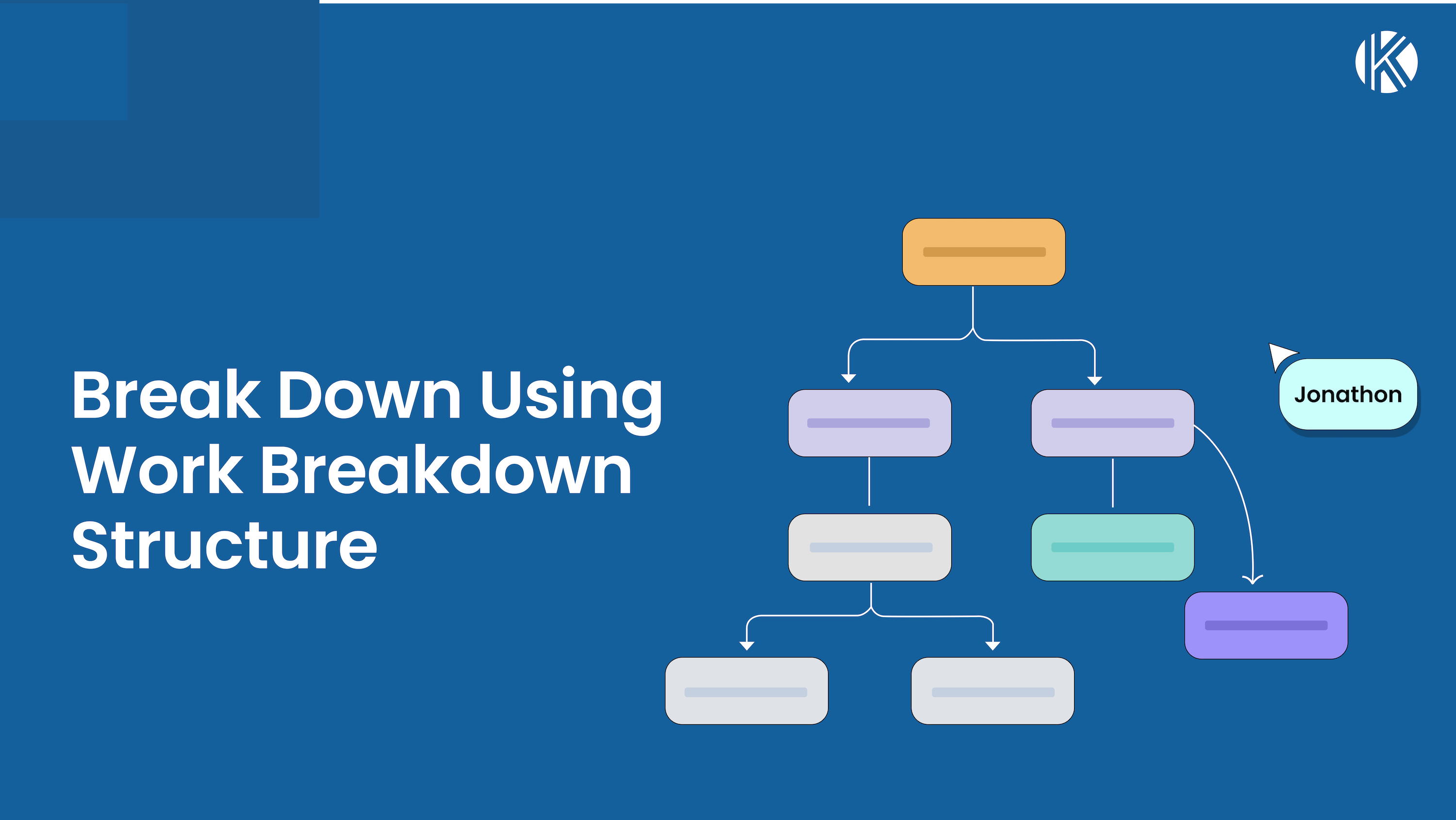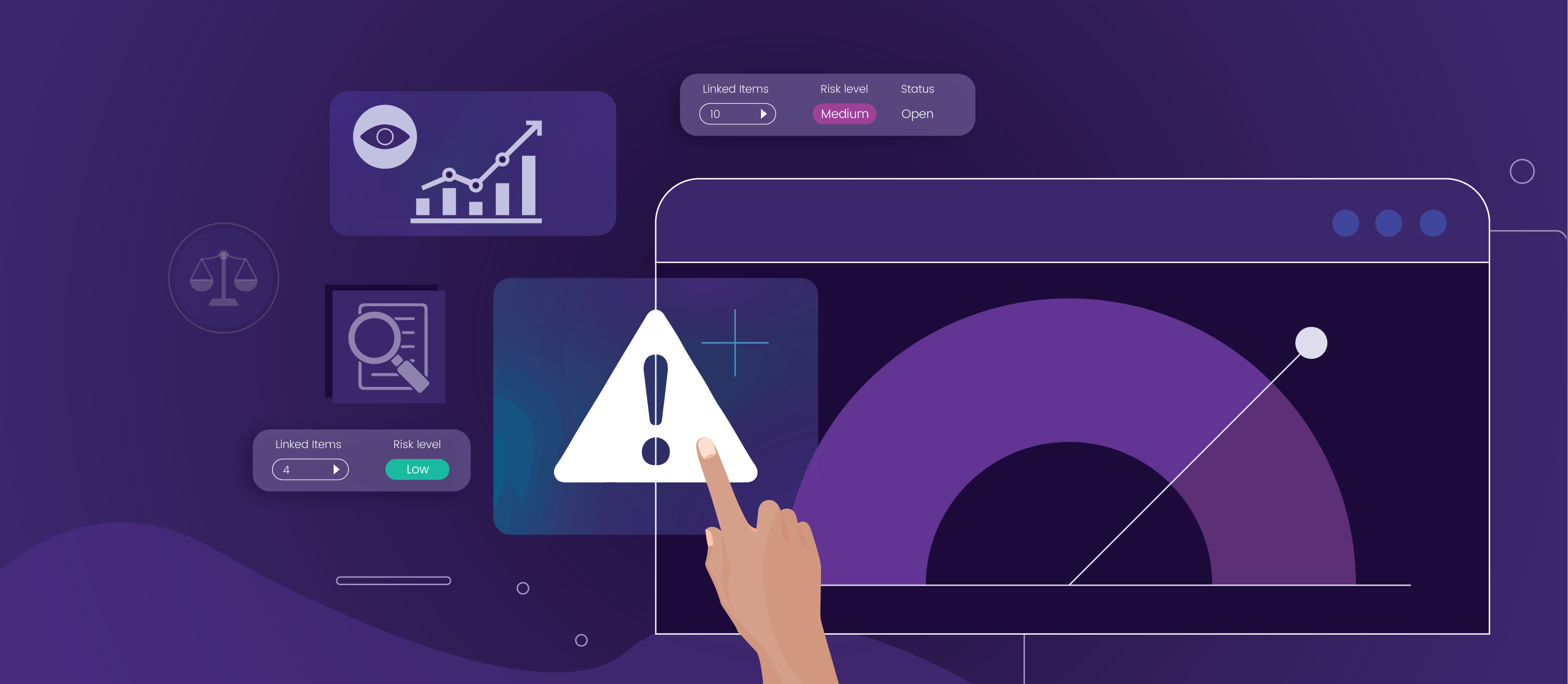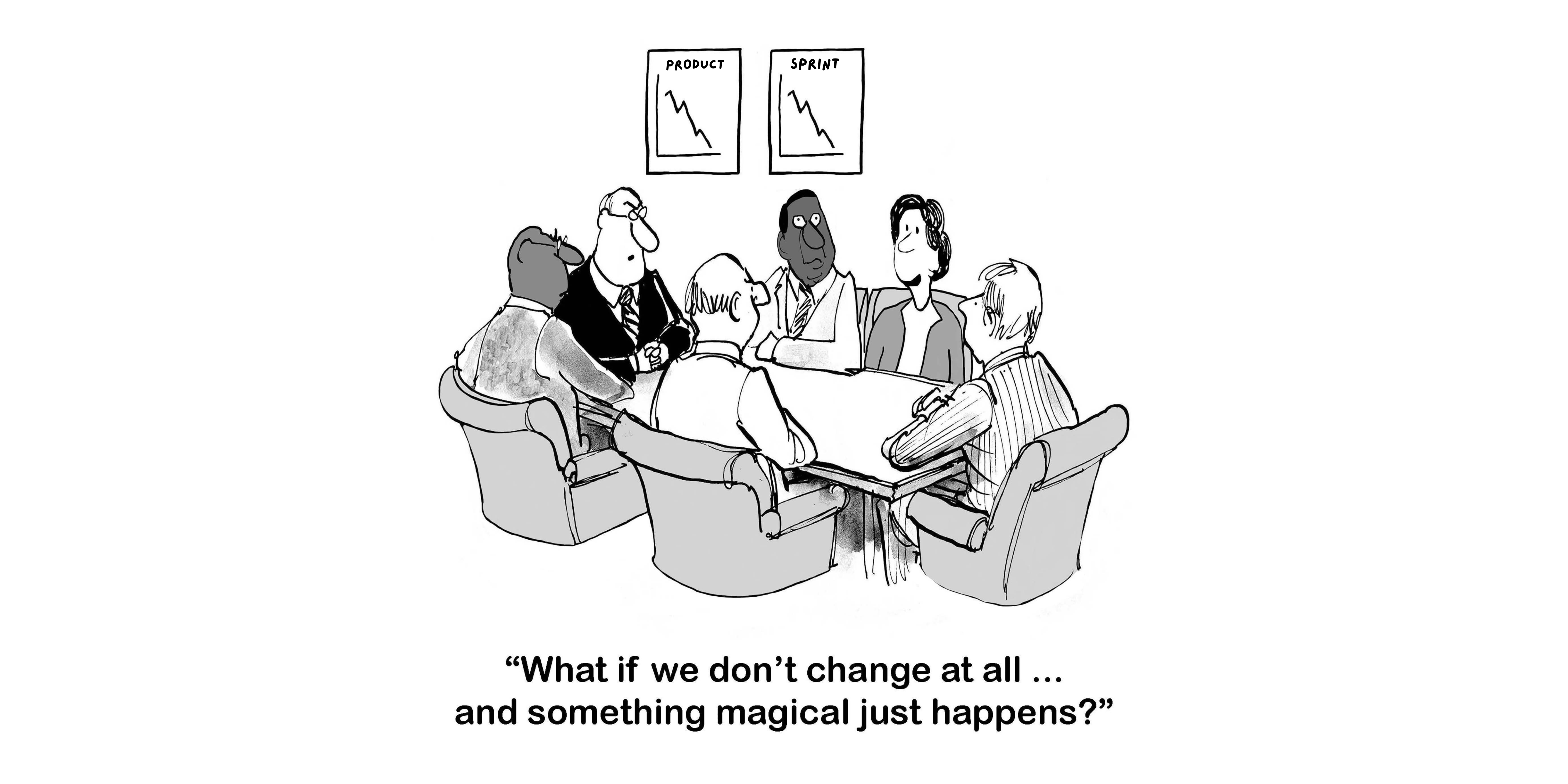“Definiteness of purpose is the starting point of all achievement” – W. Clement Stone
How do you define your project? What is the first step in setting a clear direction? Addressing these uncertainties begins with creating a draft view that aligns with your objectives while identifying the areas of the organization that will be impacted. Establishing a hierarchy that connects the strategic vision to operational tasks is crucial for ensuring alignment and clarity across all levels.
The key to answering these questions lies in avoiding giant leaps and progressing to uncover the project’s true purpose step by step. Below are essential steps for defining your project and its scope. With Kendis as your partner, you can ensure successful project delivery by establishing a clear and actionable framework.
Establish Clear Objectives and Define Scope
Defining project objectives and scope is the cornerstone of successful project planning. To set objectives effectively, start by envisioning the desired result, and what the project aims to achieve and work backward from there to outline how to get there.
To begin, ask key questions that clarify the purpose and boundaries of the project:
- Why are these objectives important? What is the underlying need or problem the project addresses?
- How will the project be executed? What approach or methodology will guide the work?
- What will be included in the scope? What tasks, deliverables, or features are essential, and what should be excluded?
- How will the project stand out? What differentiators will make it unique or competitive in the market?
- What benefits will the project deliver? Consider both tangible outcomes, like cost savings or increased efficiency, and intangible ones, like enhanced customer satisfaction.
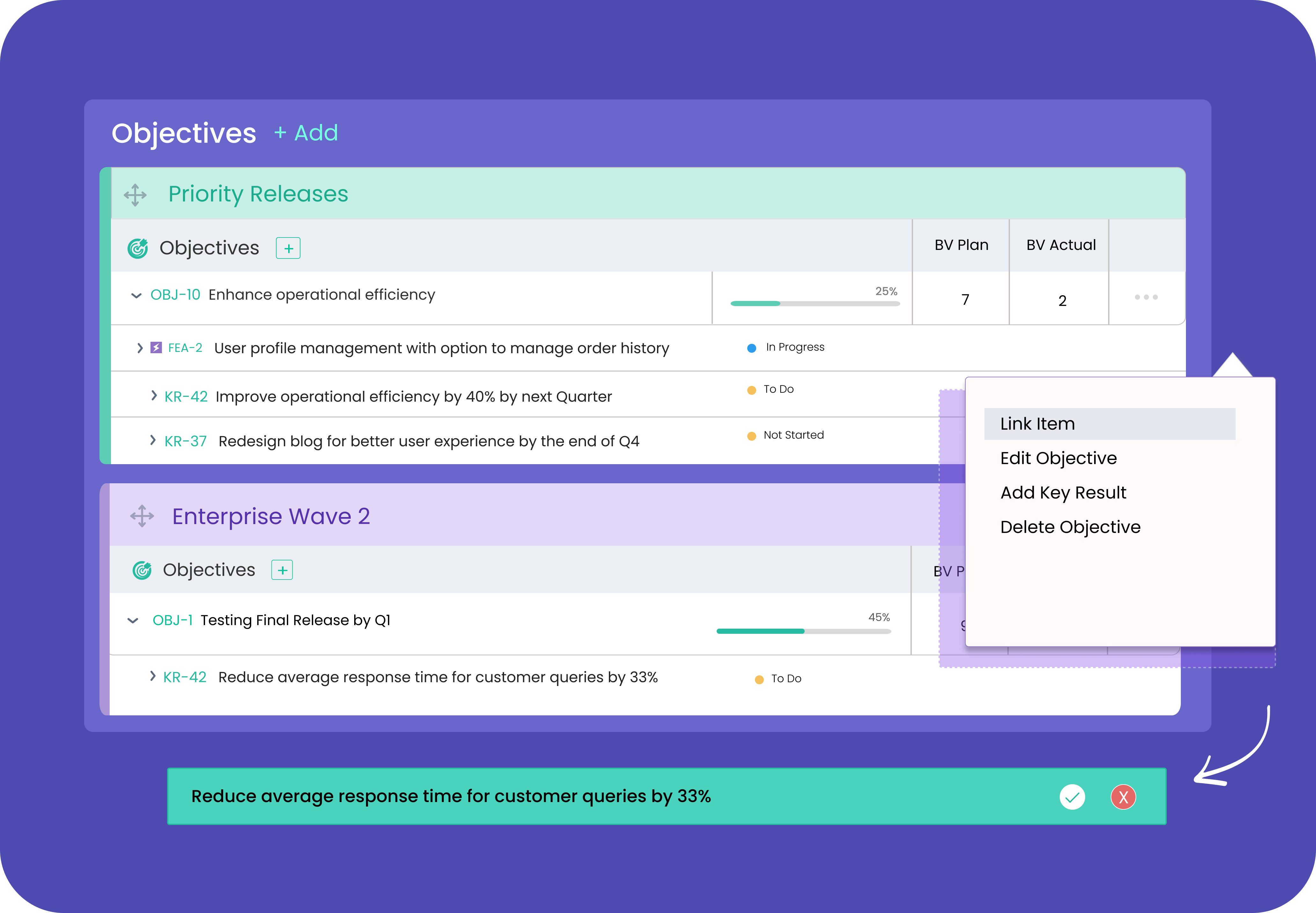
Engaging in open discussions with experts, practitioners, and subject matter experts (SMEs) is a valuable way to shape objectives. Including customers or end users in these conversations helps ensure that the project aligns with their needs and expectations. These discussions should remain exploratory, focusing on generating ideas good or bad asking questions, and examining key factors to gain clarity and refine the scope.
Objectives should address financial considerations, functional requirements, and long-term business goals, forming a clear and strategic foundation for the project. They should reflect not only what needs to be achieved but also how the project aligns with the broader organizational goals. Write these objectives down, organize them in a central location, and view them as living documents that can evolve as the project progresses. This approach ensures that your objectives remain clear, actionable, and aligned throughout the project’s lifecycle.
To better understand how objectives should be created, here is an example for you. You are a family of five and want to build a 4-bedroom modern home that combines comfort, and sustainability, and is aesthetically appealing. You want the home to be energy efficient through solar panels and eco-friendly materials, and also to serve as a functional and adaptable space for your family.
Example – House Building – Establishing Clear Goals and Objectives
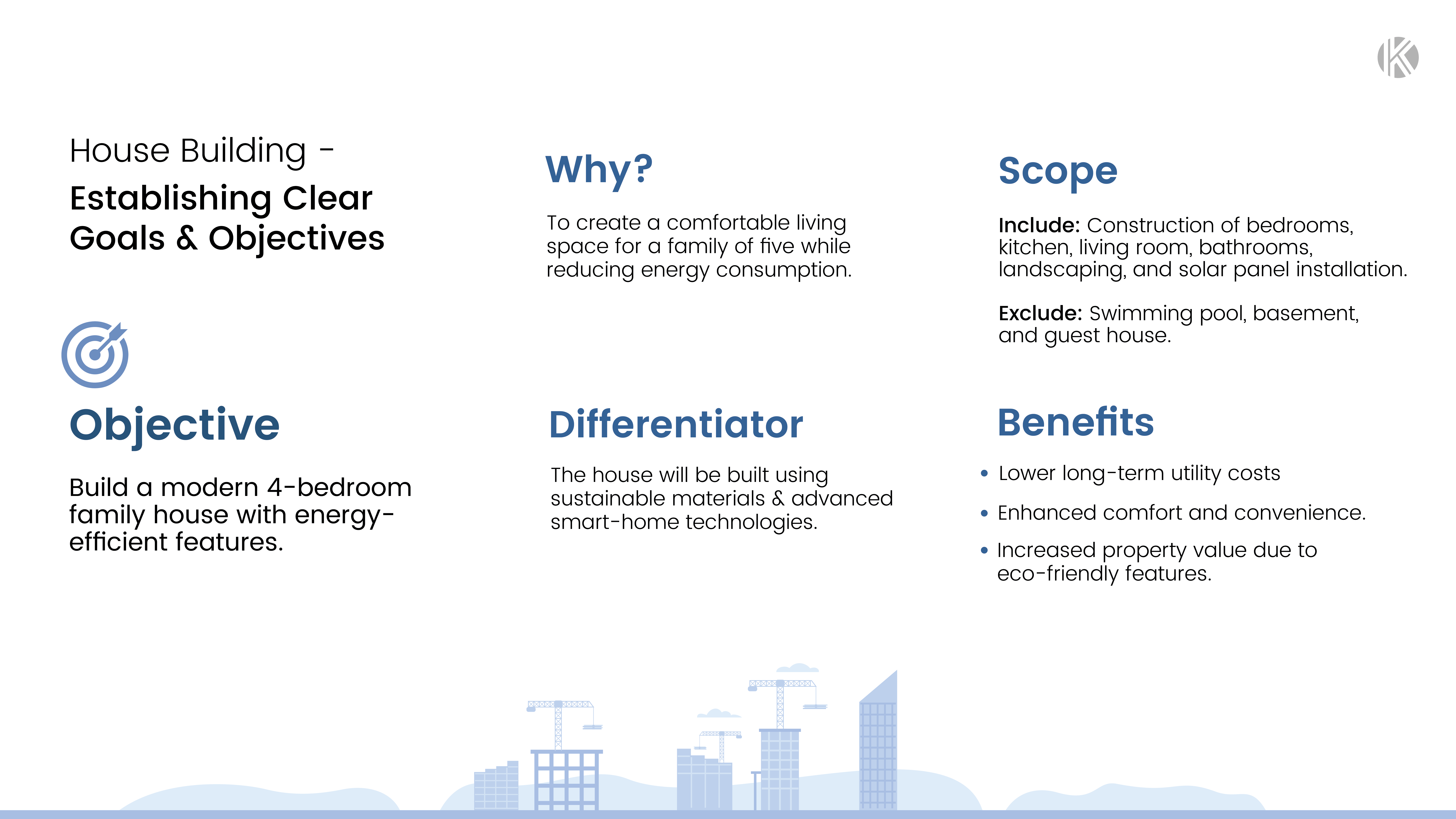
Objective
Build a modern 4-bedroom family house with energy-efficient features.
Why
To create a comfortable living space for a family of five while reducing energy consumption.
Scope
- Include: Construction of bedrooms, kitchen, living room, bathrooms, landscaping, and solar panel installation.
- Exclude: Swimming pool, basement, and guest house.
Differentiator
The house will be built using sustainable materials and advanced smart-home technologies.
Benefits
- Enhanced comfort and convenience
- Lower long-term utility costs
- Increased property value due to eco-friendly features
Key Questions to Ask
- Why is this house being built?
- What features are essential (must-haves)?
- What optional features (nice-to-haves) should be considered?
Using this example, the objective is clear and ensures that everyone is working towards a unified goal. Clearly outlining the scope with what will be included and excluded, will prevent unnecessary additions that could inflate costs or derail timelines. Highlighting unique differentiators, like using eco-friendly materials and smart-home technologies, adds value and guides design choices. Articulating benefits, such as enhanced comfort, lower utility costs, and increased property value, provide motivation and clarity. Finally the section for Key questions, like determining must-have versus nice-to-have features, ensures priorities are addressed effectively. By establishing these fundamentals, the project avoids scope creep, facilitates resource allocation, and provides a clear roadmap for planning, decision-making, and risk management.
Establishing Clear Goals and Objectives in Kendis
Kendis provides a centralized platform to document and refine project objectives, ensuring alignment across teams. With customizable fields, you can clearly define the “what” and “why” of your project and capture high-level requirements. Collaborative features allow team members, delivery leads, and stakeholders to contribute ideas, ensuring your objectives reflect both business goals and end-user needs. This transparency creates a shared understanding that drives your project forward.
Additionally, Kendis enables organizations to track strategic themes across departments, ensuring alignment with broader objectives. Strategic themes can flow down into team-level objectives, creating a seamless connection between high-level goals and actionable work. Kendis also allows you to link these themes with ALM work items, such as features or user stories, enabling progress tracking and performance measurement. This comprehensive approach ensures that every objective, from the strategic level to individual tasks, is clearly defined, measurable, and aligned with your organization’s overall vision.
Communicate with Key Roles and Departments to help define scope
When defining project goals and scope, it’s common to face uncertainty about who should be involved and how to gather the necessary information. Addressing these uncertainties starts with asking key questions:
- Which departments or stakeholders need to contribute to defining the project’s objectives?
- Who has the expertise to clarify the scope and break it into manageable components?
- What resources or tools are required to ensure a clear and actionable plan?
Breaking the project into smaller project breakdowns can help clarify these roles and responsibilities. For instance, a Product Owner might lead the definition of the product vision and objectives, while Developers provide input on what is technically feasible within the defined scope. A Scrum Master or Project Manager ensures that the scope remains realistic by coordinating discussions, managing timelines, and fostering alignment between teams. Subject matter experts or QA Engineers may also play a role in identifying critical deliverables to ensure the scope addresses quality expectations and end-user needs.
Collaboration across various departments is essential to refine and validate the scope:
- UX/UI Team: Contributes insights on user experience and ensures design elements align with project objectives.
- DevOps: Provides input on infrastructure needs and deployment pipelines that could impact scope.
- Finance: Reviews budget implications of the proposed scope and approves necessary resources.
- Customer Success or Support Teams: Offer valuable insights into end-user requirements, helping refine objectives and ensure the project delivers value.
Key questions to ask during this project breakdown include:
- Who are the key stakeholders, and how can their input shape the project’s objectives?
- Are there interdependencies between teams or departments that influence the scope?
- What external factors, such as compliance or regulatory requirements, might impact the goals or scope?
Engaging these roles and departments early is critical. For example, consulting with technical leads about feasibility or discussing regulatory requirements with legal teams ensures that the scope is both practical and compliant. These conversations also help identify risks or dependencies that might otherwise be overlooked.
By involving key roles and stakeholders in defining the project’s goals and scope, you establish a clear and collaborative structure for moving forward. This process reduces uncertainty, fosters accountability, and ensures the project starts with a well-defined foundation aligned with organizational objectives.
To fully understand what roles and departments contribute to a project we will refer back to our house-building example and learn about the key roles and departments involved in building the 4-bedroom house.
Key Roles
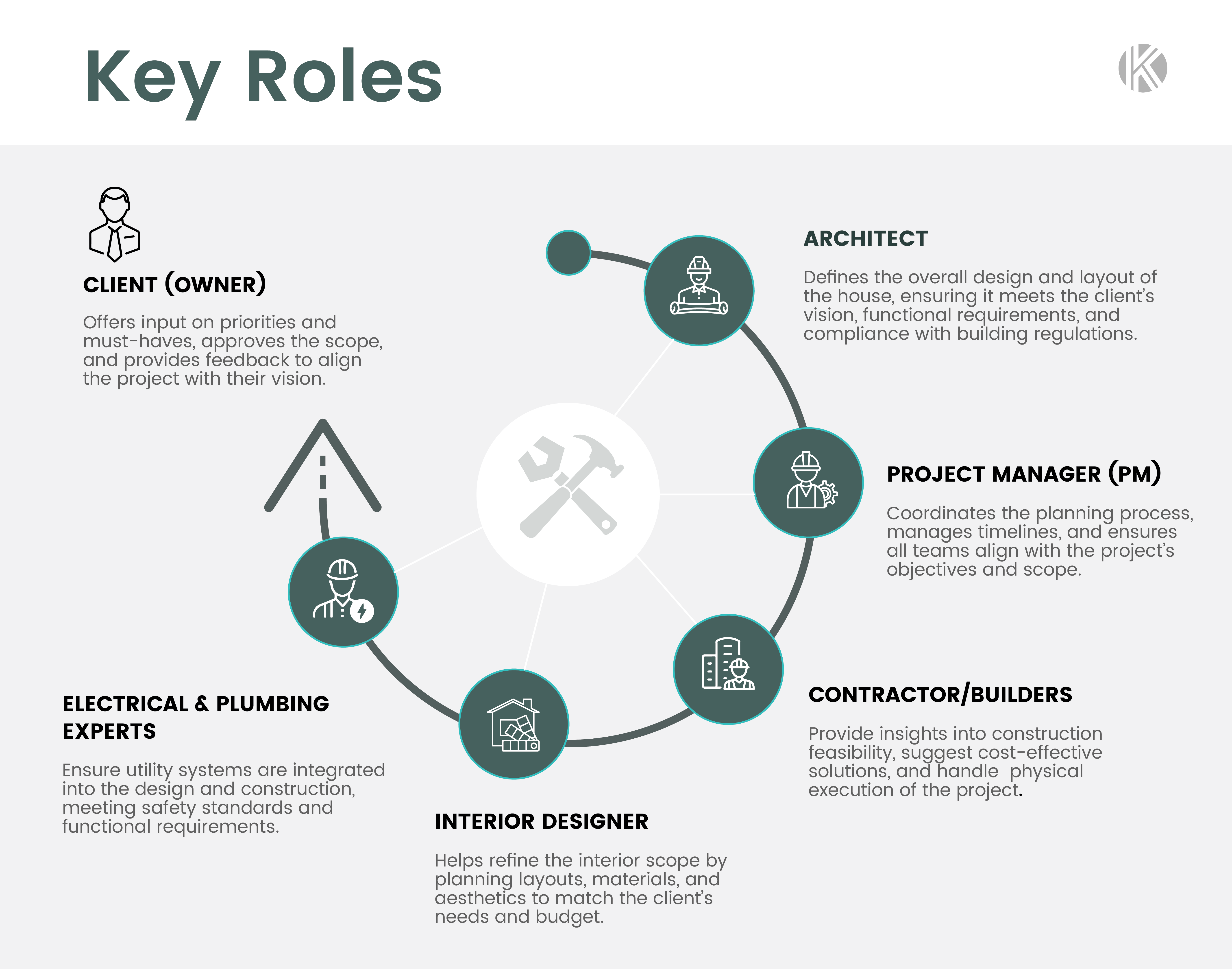
- Architect: Defines the overall design and layout of the house, ensuring it meets the client’s vision, functional requirements, and compliance with building regulations.
- Project Manager (PM): Coordinates the planning process, manages timelines, and ensures all teams align with the project’s objectives and scope.
- Contractors/Builders: Provide insights into construction feasibility, suggest cost-effective solutions, and handle the physical execution of the project.
- Interior Designer: Helps refine the interior scope by planning layouts, materials, and aesthetics to match the client’s needs and budget.
- Electrical and Plumbing Experts: Ensure utility systems are integrated into the design and construction, meeting safety standards and functional requirements.
- Client (Owner): Offers input on priorities and must-haves, approves the scope, and provides feedback to align the project with their vision.
Departments Involved:
- Legal: Ensures the project adheres to zoning laws, building codes, and environmental regulations.
- Finance: Manages the budget, approves payments, and provides clarity on funding constraints.
- Operations: Oversees sourcing materials, hiring labor, and scheduling resources to meet deadlines.
Identifying these key roles and departments are essential to refine and finalize the house’s goals and scope effectively. For example, the Architect’s expertise helps translate the client’s vision into a feasible design, while the Project Manager ensures alignment across teams. Builders might suggest alternatives to materials or construction methods that save costs without compromising quality. Meanwhile, legal and finance departments ensure compliance and budgetary adherence.
This collaborative approach not only ensures the project begins with clear goals and a well-defined scope but also allows adjustments during planning based on expert input. This alignment across stakeholders ensures the project progresses efficiently, with accountability at every stage, delivering a house that fulfills the client’s vision and needs.
How Kendis Facilitates Communication and Collaboration
With the defined scope, key roles, and departments, it’s time to bring your project to life with Kendis. Kendis is equipped to transform your raw and initial planning approaches into a refined game plan by providing you with the following features:
Centralized Repository for Stakeholder Input
Kendis allows teams to document objectives, scope details, and stakeholder contributions in one place. Whether it’s capturing initial ideas from key roles or refining the scope with expert input, Kendis ensures everyone has access to the latest updates.
Customizable Views for Tailored Communication
Different stakeholders require different levels of information. A technical lead may need detailed task dependencies, while a business sponsor may focus on high-level milestones. Kendis’s customizable dashboards and views ensure each stakeholder sees the information most relevant to their role, fostering clarity and minimizing miscommunication.
Mapping Roles to Objectives and Deliverables
Using Kendis, teams can assign roles to specific objectives or deliverables, ensuring accountability. For example, a Product Owner can be linked to the definition of the product vision, while developers contribute technical feasibility assessments. This role-based structure helps ensure each contributor understands their responsibilities and impact.
Facilitating Cross-Departmental Collaboration
Collaboration across departments is often essential for defining and refining scope. Kendis helps by enabling cross-functional teams to visualize how their contributions align with the overall project. Whether it’s the UX team refining user journeys, DevOps ensuring infrastructure readiness, or Finance assessing budget implications, Kendis provides a clear view of interdependencies.
Tracking Changes and Discussions
Scope and objectives often evolve as new insights emerge. Kendis ensures every change is tracked and visible to stakeholders, reducing the risk of misalignment. For example, if a compliance requirement impacts the scope, the legal team’s input can be added and shared across the platform, ensuring timely adjustments.
Key Features for Engaging Stakeholders with Kendis
- Visual Dependency Maps: Highlight connections between deliverables and roles, helping teams identify risks and resolve conflicts early.
- Strategic Themes and Objectives: Stakeholders can track how their contributions align with larger goals, ensuring their work supports organizational priorities.
- Integrated Communication: Kendis integrates with tools like Jira and Azure DevOps, so conversations about tasks and scope can be seamlessly linked to the actual work.
- Quarterly Planning Views: Plan and communicate priorities in manageable increments, making it easier for stakeholders to focus on immediate goals without losing sight of long-term objectives.
Kendis is more than a project management tool, it’s a powerful platform designed to help programs visualize the defined scope, foster collaboration with key stakeholders, and maintain alignment with organizational goals. By centralizing communication and offering customizable views, Kendis ensures all stakeholders have clarity on project objectives and progress, creating a shared understanding and fostering accountability. From defining project scope to tracking execution, Kendis provides the tools needed to confidently deliver exceptional outcomes.
Once the scope is clearly defined and aligned, the next step is to Establish high-level project breakdowns in Kendis. This approach allows teams to break the project into manageable increments, visualize dependencies, and effectively for successful delivery. Let’s explore how Kendis can help structure these project breakdowns and drive progress.
